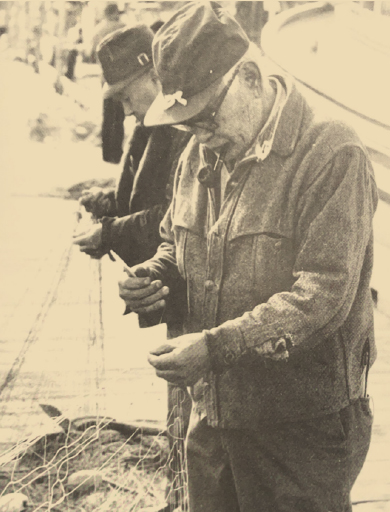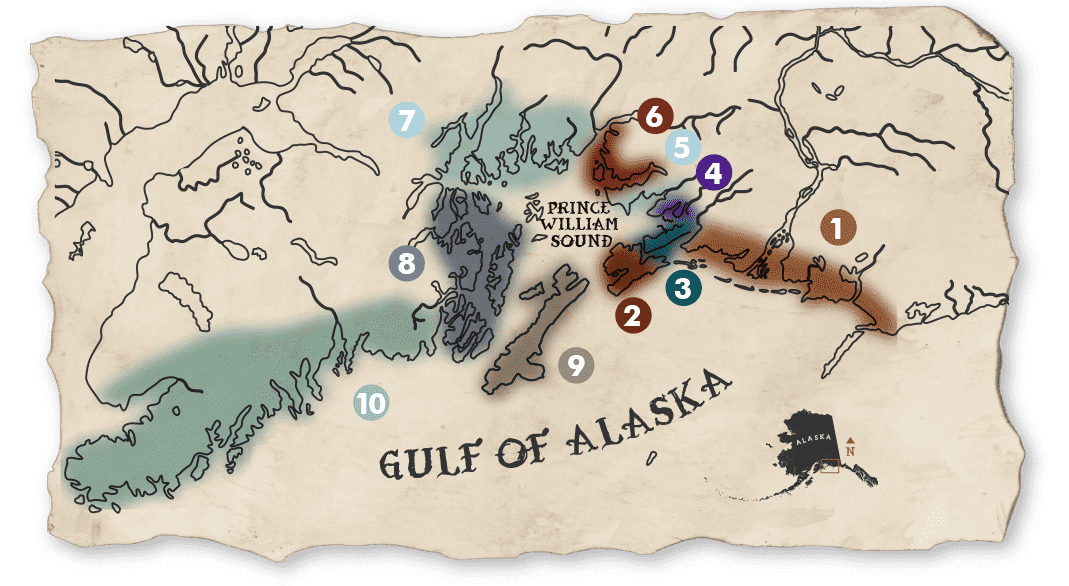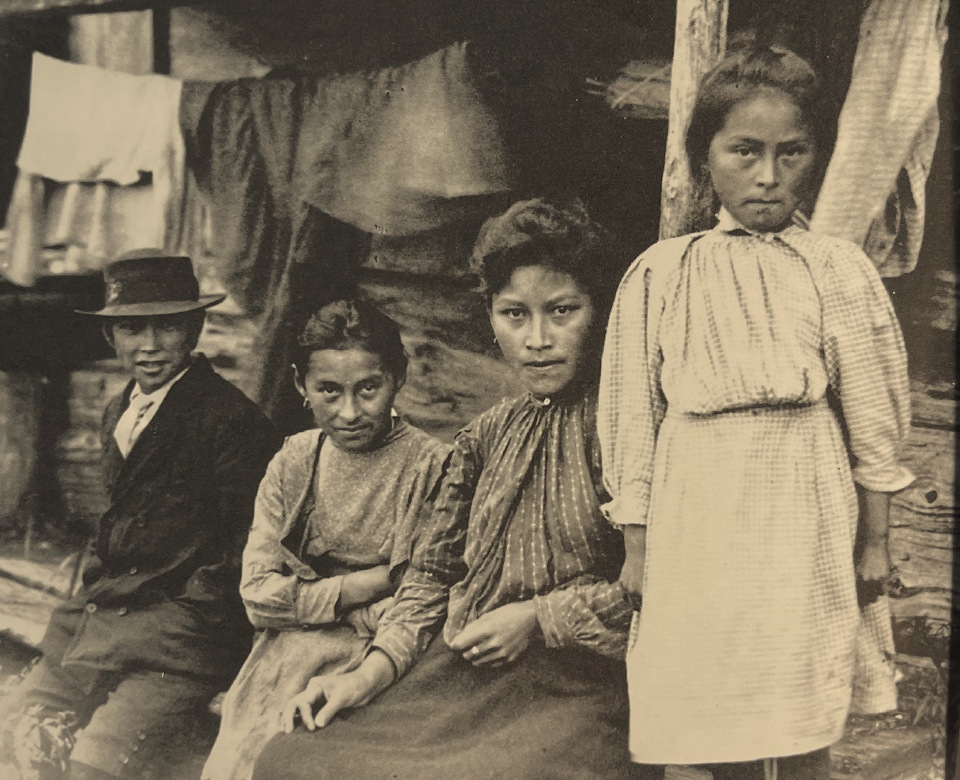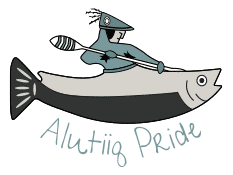OUR PEOPLE
We are the Chugach

Story Told by John Kalashnikoff
Shared from Chugach Legends – Stories and Photographs of the Chugach Region
For ages of ages, Prince William Sound, as it was named by Captain James Cook, was covered by a solid sheet of glacier ice that extended over nearly all of the bays and mountains. One day Native hunters were kayaking along the outer shores of the Pacific Ocean, when a man cried out: “Chu-ga, Chu-ga” (Hurry, Hurry). “Let’s go see what that black thing is sticking out of the ice.” So, the hunters paddled closer and closer to see what it was. Within a short distance, the hunters could see mountaintops emerging out of the retreating ice. Thus, these ocean travelers settled along the ice-free southern shores of the Sound. As the seasons changed from year to year the ice melted rapidly, exposing deep fjords and lagoons that were rich in sea life and provided good beaches to settle on. It was known that life thrived in the areas where the salt and fresh water met. When the ice retreated, so did the animals. The Chugach people followed the ice and animals deep into the heart of Prince William Sound, where they remain to this very day.
Imagine a place where the mountains shoot up from the ocean, glaciers you can walk on that touch the ocean’s tides, and a place full of life from the sky to the rocks in the water. With over 6 million acres (about the size of New Jersey) of land and over 5,000 miles of coastline, this is Chugach, where over 1,500 Alutiit/Sugpiat and dAXunhyuu (Eyak) people call home. These Southcentral coastal people of Alaska make up Tribes of the Chugach region of the Prince William Sound, Lower Copper River, and Lower Cook Inlet area. Historically, many villages were nestled in bays, beside lakes, and alongside rivers throughout the region.
The First Communities

1 • EYAK
The territory of the Eyak People (dAXunhyuu) is the mainland of Nelson Bay to Controller Bay, where there were approximately five main villages and several camps: AnAXAnAG (Alaganik), near mile 21 of the present-day Copper River Highway; iiyaaG (Eyak), near mile 5.5 of the present-day Copper River Highway; tsaalAxa’luw (Mountain Slough), 800 yards south of iiyaaG; aagah daad (Orca), near present-day Cordova toward Nelson Bay; xaxtl’i (Okalee), in Controller Bay. There is a story about when Raven created the land, he created Okalee Spit first. Today you can find a large rock on the spit that has indents that look like Raven had perched there. In addition to these villages there was an important fish camp near Point Whitshed that was shared with the Shallow Water People called digiLXah lAGd.
2 • NUCHEK
The territory of the Nuchek people (nutyirmiut) is home to one of our oldest-known village sites. There were approximately six villages and camps on the western side of Hinchinbrook Island, including Cape Hinchinbrook to Anderson Bay.
3 • SHALLOW WATER
The territory of the Shallow Water People (txalaymiut) is on the eastern half of Hinchinbrook Island to Mummy Island and includes Point Whitshed and Hawkins Islang. There were several camp sites and a handful of villages throughout this area, but the main village was Palugvik, where the Chief lived.
4 • SHEEP BAY
The territory of the Sheep Bay People (alukaymiut or kaniymiut) was the smallest group claiming land between Sheep and Simpson Bay. There were approximately three villages/camps in the area. The beach northeast of Anderson Island was called uyumeqtuli, and it is where Raven first brought fire.
5• PORT GRAVINA
The territory of the Port Gravina People (atiaymiut) is the mainland between Gravina Point to Porcupine Point. The main village of this area was Olsen Bay, but there were a handful of other villages and camps scattered throughout.
6 • TATITLEK
The territory of the Tatitlek People (tatilaymiut or Tatilaq) included all of Port Fidalgo northeast to present-day Valdez. There were at least 10 villages and camps throughout Fidalgo, the Islands of Boulder Bay, Tatitlek Narrows, Ellamar, Galena, and Bligh Island.
7 • KINIKLIK
The territory of the Kiniklik People (kanixluymiut) contained the greatest number of glaciers to reach the tidewater. There were several villages and camps near Long Bay, Unakwik, Wells Bay, Kiniklik, Eaglek, Esther Passage, and Port Wells. It is said that pukituq, who turned into different animals, lived near Wells Bay.
8 • CHENEGA
The territory of the Chenega People (taniymiut) was one of the largest groups claiming the western part of the Sound below Port Wells. There were villages and camps near Culross Island, Eshamy, Ewan, Jackpot Bay, Knight Island, Bainbridge Island, Evan Island, Elrington Island, and Latouche Island. Chenega Island was home to the main island, inimatia, “Under the Mountain.” It is said that Knight Island was shared hunting grounds.
9 • MONTAGUE ISLAND
The territory of the Montague Island People (cuqluymiut) is the largest island in Prince William Sound. There were five villages and several camps. The people were known to be great sea otter hunters.
10 • KENAI
The territory of the Kenai Peninsula People (unixkuymiut) was on the southern shores of the Kenai Peninsula. Historically, the inhabitants were not considered a part of the Chugach region until more recent years. These people extended across Puget Bay to Cook Inlet, including Kachemak Bay. There were villages near present-day Port Graham, English Bay, Koyoktolik (Dog Fish Bay), and the east coast near Kachemak Bay.
Information from Chugach Prehistory • the Archeology of Prince William Sound Alaska, by Fredrica de Leguna
The Land
of the Sugpiat
& dAXunhyuu
As time past, the first communities have come together as seven distinct Tribes: Chenega, Eyak, Nanwalek, Port Graham, Qutekcak, Tatitlek, and Valdez. Two languages spoken here are Sugt’stun (Lower Cook Inlet and Prince William Sound dialects) and the reviving dAXunhyuuga’ language of Eyak. This area has been honored with many Alaska Native cultures. The Tlingit would sail north in cedar war canoes, the Eyaks floated south on the Copper River in cottonwood canoes, and the Sugpiat paddled in seal- and seal-lion-skin qayaqs from island to island in the Gulf of Alaska and Prince William Sound. Occasionally, this area would also be visited by Ahtna and Dena’ina Athabaskans and Unangax. Our dAXunhyuu are the Wild Copper River Salmon People, the traditional stewards of the Copper River Delta region. dAXunhyuu means “Throat of the Lake, where the lake becomes the river.” We chose these sites because that is where the freshest wild salmon would be. Our Sugpiat Imam suga are the people of the sea; the traditional stewards of the Lower Cook Inlet and Prince William Sound. The identity of our people is established by the resources we use.


The people of our region have called Chugach home for 10,000 years since our glaciers have receded and our mountaintops emerged from the ice. As stewards of the region, we have had an intricate, respectful, and protective relationship with our land and its resources. Disruptions to traditional cultural ways started in the middle of the 18th century when Russian explorers entered the Chugach region. The Chugach people were the first to meet explorer Vitus Bering’s expedition, which came to Alaska in 1741 under the Russian flag.
The Chugach people successfully kept Russian explorers from utilizing the Chugach region until the late 18th century, when Russians began occupying portions of the region and enslaving the Chugach people. Aleksandr Baranov dominated the early Russian occupation, and Chugach men were forced to hunt for sea otters for the Russians, who were heavily involved in the fur trade during this time. European explorers followed the Russians into the region and created further disruptions to the Chugach lifeways.
Since the founding of Fort Saint Constantine at Nuchek in 1793, Russian culture has played a significant role in Chugach history. Famous Spanish explorer Salvador Fidalgo came to the Prince William Sound in 1790, which is why you see names like Cordova, Valdez, and others that stem from the Spanish language. Additionally, other European and American explorers have left their mark on the region. During the early American period, the wealth of the region’s minerals and fisheries attracted immigrants from all corners of the globe.
By 1861 Americans were a commercial force in North Pacific, and the Russian American Company was on the brink of bankruptcy. Fur trading declined and other commercial endeavors failed, including coal mining, timber harvesting, and ice operations. Competition with other companies was fierce, and the ability of Russia to successfully defend Alaska from other countries proved difficult. Russia believed Alaska to be owned by them and decided to sell Alaska to the United States in 1867.
The Chugach people, like all Alaska Native people, were treated as second-class citizens, with the United States purchasing Alaska from the Russians. Population increased in Southcentral Alaska after the purchase and rose sharply in the 1940s with the arrival of military personnel to fight in the Pacific Theater during World War II. The influx of non-Native peoples moving into the region brought illness (influenza, chicken pox, meningitis, whooping cough) to the Chugach people, who had no immunity. The lack of immunity caused a sharp decline in the Chugach Native population as many fell ill and never recovered from sickness. Other disruptions included highway building, mining, missionaries, boarding schools, and the overharvest of subsistence species taken as trophy animals.

Reclaiming Our Identity
The late 1960s became a time of revolution for the Chugach Natives people. This began the civil rights movement when leaders and Native citizens fought for their rights. The Chugach region banded together, and in the coming years, ANSCA corporations were created, Tribal Villages were established, racist signs were taken down from buildings, and Chugach Natives took back their identity. In the 1990s, culture camps were created to bring the region together to relearn arts, history, skills, and traditions suppressed for 200 years.
Reintroducing Our Culture

Since 1993, Tatitlek has hosted an annual Cultural Heritage Week, also known as Peksulineq, every May. The mission of Peksulineq is to help preserve Tatitlek’s culture and heritage through fun classes like carving, skin sewing, beading, fish processing, basket weaving, and more! At the same time, Nuuciq Spirit Camp was established. Participants attend camp for a one-or two-week session where they travel by boat or floatplane to Hinchinbrook Island to the long-standing traditional village of Nuchek to learn about and celebrate their culture and heritage. Classes offered from year to year include plant lore, bidarka (qayaq) building, drum making, traditional song and dance, dAXunhyuuga’ and Sugt’stun language, beading, basket weaving, fur sewing, carving, and subsistence activities like learning to catch, clean, smoke, and can salmon; hunting seals, sea lions, and deer and learning how to process and preserve the meat; and collecting and eating chitons and snails at low tide. These camps were created for bringing the Chugach region people together while teaching the culture, heritage, traditions, and subsistence lifestyle. On the Lower Cook Inlet, Nanwalek hosts a camp called Sea Week, and Port Graham hosts Fun in the Sun for students to learn about environmental science while incorporating language, culture, and knowledge on traditional foods that are harvested from our marine ecosystems. It is vital to share this knowledge with the younger generations to ensure that it is passed on to future generations.
Learn More about Our History
In the Chugach region, we maintain our culture through oral history. Visit our Resources for information regarding our history or click on some of the links below.

